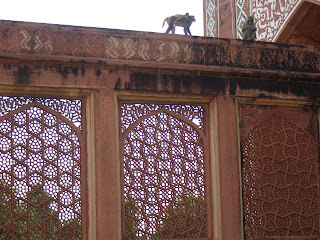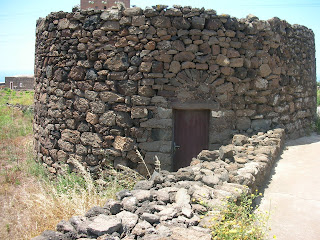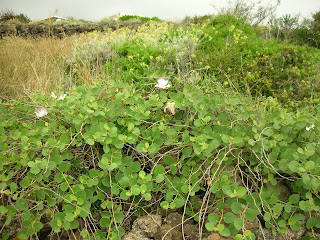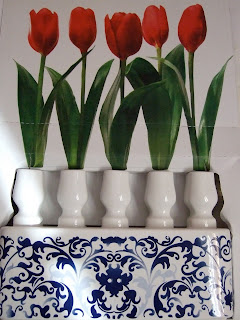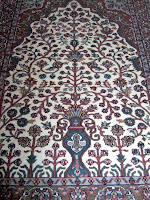Geometry expressed harmony in the universe. If palace gardens were for pleasure, tomb gardens were the closer realization on earth of the Islamic paradise.
 At Sikandra, the scheme follows the rules of the char bagh, with two perpendicular khiybans, a raised paved walkway, that divide the garden in four equal parts. The mausoleum stands on a raised platform at their crossing point and gates, aligned to cardinal points, terminate each causeway. The four imposing gates have different size but the same structure based on a central iwan with arched wings on both sides, completed with elegant chattris and rich decorations. These are more sumptuous on the South gate, the only true entrance, and just fragments on the ruins of the North gate, which was struck by lighting some years ago.
At Sikandra, the scheme follows the rules of the char bagh, with two perpendicular khiybans, a raised paved walkway, that divide the garden in four equal parts. The mausoleum stands on a raised platform at their crossing point and gates, aligned to cardinal points, terminate each causeway. The four imposing gates have different size but the same structure based on a central iwan with arched wings on both sides, completed with elegant chattris and rich decorations. These are more sumptuous on the South gate, the only true entrance, and just fragments on the ruins of the North gate, which was struck by lighting some years ago.
Narrow water canals run along the center of the broad pavement interrupted by rectangular fountains, replicated on each side of the square platform. In old times, water stored from the river flowed to canals from overhead tanks to ensure pressure. Besides, in times of drought, several wells distributed in the garden provided water to the fountains through a complex system of underground glazed clay pipes. Today, the shallow canals are dry, but their original meaning is not lost. They are the Four Rivers of Paradise, flowing from the Sacred Mountain to bring life to the world with water, milk, honey and wine. Architectural elements translated an idea of Paradise inspired by Islam but common to many religions, including Hinduism and Buddhism.
The mausoleum, the Cosmic Mountain, is a five-tiered stories building, like a truncated pyramid. The large ground floor is developed in vaulted galleries supported by impressive pillars. A central pishtaq, an imposing arch surrounded by a rectangular frame, stands on each side of the building enriched with elaborated marble decorations and delicate chhattris. Entrance to the burial chamber is on the southern side, through a narrow and inclined corridor. In the vestibule that precedes it, time is devouring the refined stucco decorations and the golden inscriptions that stand against the blue background. The sarcophagus is a simple white marble parallelepiped. An ever burning lamp, suspended above it, provides a dim light toghether with four small windows that open eighteen meters above, the height of this domed chamber that reaches the third floor. Whitewashed walls and stone floor are not its original layout. There were paintings of angels and other Christian subjects on the walls and rich carpets spread on the floor, while armors, books and clothes of the emperor were placed around the tomb. Everything was pillaged together with jewels, gold and silver by marauders at the end of the XVII century. The emperor is not alone, in nearby chambers are the tombs of two daughters.
The three storeys above, each one smaller than the one below, are slender pillared pavilions made of red sandstone and ornate with domes and white marble chhatris. Building materials had local origin and recall, with their colors, the purity and the royalty of the place. Until then, white marble was used just for saints’ shrines, while red was the color of the imperial tents.
 Access to the top story is not guaranteed. Here, under the tropical sun and violent monsoons, is a white marble cenotaph carved with the ninety-nine names of God, arabesques and floral motives. A square pedestal, similarly decorated, stands at the north end of the cenotaph. It is supposed to be a base for lamps or censer during celebrations. An arched cloister of white marble, closed on three sides with finely crafted screens, surrounds it. There is no roof. Some people consider the building unfinished, others explain this choice with a rigid interpretation of Muslim burial precepts, but others, fascinated by the ever changing reflection of light on the marble surface, think of Akbar and his lifelong search for divine. In 1641, two hundred men read the Quran in nearby chambers to celebrate the holiness of the tomb, whose head is turned towards the rising sun and not towards the Mecca.
Access to the top story is not guaranteed. Here, under the tropical sun and violent monsoons, is a white marble cenotaph carved with the ninety-nine names of God, arabesques and floral motives. A square pedestal, similarly decorated, stands at the north end of the cenotaph. It is supposed to be a base for lamps or censer during celebrations. An arched cloister of white marble, closed on three sides with finely crafted screens, surrounds it. There is no roof. Some people consider the building unfinished, others explain this choice with a rigid interpretation of Muslim burial precepts, but others, fascinated by the ever changing reflection of light on the marble surface, think of Akbar and his lifelong search for divine. In 1641, two hundred men read the Quran in nearby chambers to celebrate the holiness of the tomb, whose head is turned towards the rising sun and not towards the Mecca.
From here, the sight of the garden was magnificent. No green lawns in Mughal times but beds full of fruits trees and flowers, that echoed the main fourfold structure in their obsessive concentric subdivision. There were mango, mulberries, figs and oranges doubled with a line of cypress close to the walk path. Fruit trees were symbols of life, cypress recalled death and eternity. Flowers exploded in carpets of marigolds, roses, poppies, carnations, jasmine and peonies. They could be admired from the causeways or, descending the steps, moving closer to their perfumes and to the fresh appeal of the murmuring water. This fell from abshars, or water chutes, placed in the middle of the stairs with small pools filled with lotus at their end. In the flat Agra plains, this was a satisfying solution to replace the beloved terraced gardens that flourished on the far hills of Kashmir.
It is said that Akbar started the building during his last years. Agra was the capital again, the center of the empire with efficient roads connecting the furthest towns and congested trades along the Yamuna River. Palaces, houses and the Fort looked from the right bank to the gardens that flourished, without interruption, along the opposite left bank. His son Jahangir finished it. Dissatisfied with the work already done, he ordered to partially rebuild it. He wanted a noble, magnificent monument to celebrate a father he had fought for long years. Amusing tales will perpetrate the name of Akbar as a bizarre sovereign forever; this garden will tell about beauty, respect and faith.
Stated on the south door is:
“The pen of the mason of the Divine Decree has written on its court;
These are the gardens of Eden, enter them and live forever.”
 At Sikandra, the scheme follows the rules of the char bagh, with two perpendicular khiybans, a raised paved walkway, that divide the garden in four equal parts. The mausoleum stands on a raised platform at their crossing point and gates, aligned to cardinal points, terminate each causeway. The four imposing gates have different size but the same structure based on a central iwan with arched wings on both sides, completed with elegant chattris and rich decorations. These are more sumptuous on the South gate, the only true entrance, and just fragments on the ruins of the North gate, which was struck by lighting some years ago.
At Sikandra, the scheme follows the rules of the char bagh, with two perpendicular khiybans, a raised paved walkway, that divide the garden in four equal parts. The mausoleum stands on a raised platform at their crossing point and gates, aligned to cardinal points, terminate each causeway. The four imposing gates have different size but the same structure based on a central iwan with arched wings on both sides, completed with elegant chattris and rich decorations. These are more sumptuous on the South gate, the only true entrance, and just fragments on the ruins of the North gate, which was struck by lighting some years ago.Narrow water canals run along the center of the broad pavement interrupted by rectangular fountains, replicated on each side of the square platform. In old times, water stored from the river flowed to canals from overhead tanks to ensure pressure. Besides, in times of drought, several wells distributed in the garden provided water to the fountains through a complex system of underground glazed clay pipes. Today, the shallow canals are dry, but their original meaning is not lost. They are the Four Rivers of Paradise, flowing from the Sacred Mountain to bring life to the world with water, milk, honey and wine. Architectural elements translated an idea of Paradise inspired by Islam but common to many religions, including Hinduism and Buddhism.
The mausoleum, the Cosmic Mountain, is a five-tiered stories building, like a truncated pyramid. The large ground floor is developed in vaulted galleries supported by impressive pillars. A central pishtaq, an imposing arch surrounded by a rectangular frame, stands on each side of the building enriched with elaborated marble decorations and delicate chhattris. Entrance to the burial chamber is on the southern side, through a narrow and inclined corridor. In the vestibule that precedes it, time is devouring the refined stucco decorations and the golden inscriptions that stand against the blue background. The sarcophagus is a simple white marble parallelepiped. An ever burning lamp, suspended above it, provides a dim light toghether with four small windows that open eighteen meters above, the height of this domed chamber that reaches the third floor. Whitewashed walls and stone floor are not its original layout. There were paintings of angels and other Christian subjects on the walls and rich carpets spread on the floor, while armors, books and clothes of the emperor were placed around the tomb. Everything was pillaged together with jewels, gold and silver by marauders at the end of the XVII century. The emperor is not alone, in nearby chambers are the tombs of two daughters.
The three storeys above, each one smaller than the one below, are slender pillared pavilions made of red sandstone and ornate with domes and white marble chhatris. Building materials had local origin and recall, with their colors, the purity and the royalty of the place. Until then, white marble was used just for saints’ shrines, while red was the color of the imperial tents.
 Access to the top story is not guaranteed. Here, under the tropical sun and violent monsoons, is a white marble cenotaph carved with the ninety-nine names of God, arabesques and floral motives. A square pedestal, similarly decorated, stands at the north end of the cenotaph. It is supposed to be a base for lamps or censer during celebrations. An arched cloister of white marble, closed on three sides with finely crafted screens, surrounds it. There is no roof. Some people consider the building unfinished, others explain this choice with a rigid interpretation of Muslim burial precepts, but others, fascinated by the ever changing reflection of light on the marble surface, think of Akbar and his lifelong search for divine. In 1641, two hundred men read the Quran in nearby chambers to celebrate the holiness of the tomb, whose head is turned towards the rising sun and not towards the Mecca.
Access to the top story is not guaranteed. Here, under the tropical sun and violent monsoons, is a white marble cenotaph carved with the ninety-nine names of God, arabesques and floral motives. A square pedestal, similarly decorated, stands at the north end of the cenotaph. It is supposed to be a base for lamps or censer during celebrations. An arched cloister of white marble, closed on three sides with finely crafted screens, surrounds it. There is no roof. Some people consider the building unfinished, others explain this choice with a rigid interpretation of Muslim burial precepts, but others, fascinated by the ever changing reflection of light on the marble surface, think of Akbar and his lifelong search for divine. In 1641, two hundred men read the Quran in nearby chambers to celebrate the holiness of the tomb, whose head is turned towards the rising sun and not towards the Mecca.From here, the sight of the garden was magnificent. No green lawns in Mughal times but beds full of fruits trees and flowers, that echoed the main fourfold structure in their obsessive concentric subdivision. There were mango, mulberries, figs and oranges doubled with a line of cypress close to the walk path. Fruit trees were symbols of life, cypress recalled death and eternity. Flowers exploded in carpets of marigolds, roses, poppies, carnations, jasmine and peonies. They could be admired from the causeways or, descending the steps, moving closer to their perfumes and to the fresh appeal of the murmuring water. This fell from abshars, or water chutes, placed in the middle of the stairs with small pools filled with lotus at their end. In the flat Agra plains, this was a satisfying solution to replace the beloved terraced gardens that flourished on the far hills of Kashmir.
It is said that Akbar started the building during his last years. Agra was the capital again, the center of the empire with efficient roads connecting the furthest towns and congested trades along the Yamuna River. Palaces, houses and the Fort looked from the right bank to the gardens that flourished, without interruption, along the opposite left bank. His son Jahangir finished it. Dissatisfied with the work already done, he ordered to partially rebuild it. He wanted a noble, magnificent monument to celebrate a father he had fought for long years. Amusing tales will perpetrate the name of Akbar as a bizarre sovereign forever; this garden will tell about beauty, respect and faith.
Stated on the south door is:
“The pen of the mason of the Divine Decree has written on its court;
These are the gardens of Eden, enter them and live forever.”
Vocabulary:
Abshar: water chute
Char bagh: introduced in India by Babur, is walled garden divided into different sections
Iwan: vaulted hall with walls on three sides and opens directly to the outside on the forth
Khiyaban: paved (raised) causeway, avenue
Pisthtaq: an imposing arch surrounded by a rectangular frame
Char bagh: introduced in India by Babur, is walled garden divided into different sections
Iwan: vaulted hall with walls on three sides and opens directly to the outside on the forth
Khiyaban: paved (raised) causeway, avenue
Pisthtaq: an imposing arch surrounded by a rectangular frame
Further reading:
From Google Books:
Catherine Ella Blanshard Asher, Architecture of Mughal India, part 1, volume 4, 1992 Cambridge University Press
C.M. Villiers-Stuart, Gardens of the great Mughals, 2008 Read Books
Christopher Thacker, The history of gardens, 1979 University of California Press
Photos:
Travelinagarden
From Google Books:
Catherine Ella Blanshard Asher, Architecture of Mughal India, part 1, volume 4, 1992 Cambridge University Press
C.M. Villiers-Stuart, Gardens of the great Mughals, 2008 Read Books
Christopher Thacker, The history of gardens, 1979 University of California Press
Photos:
Travelinagarden


